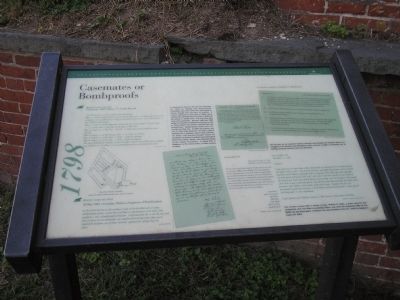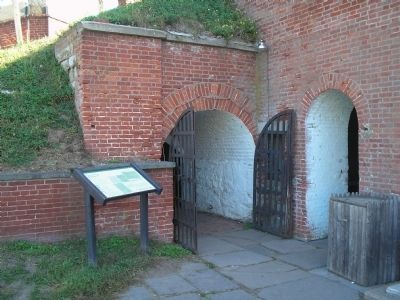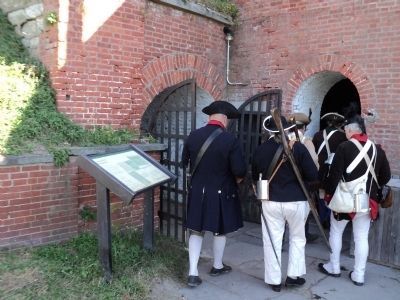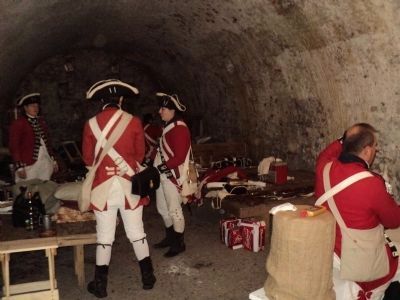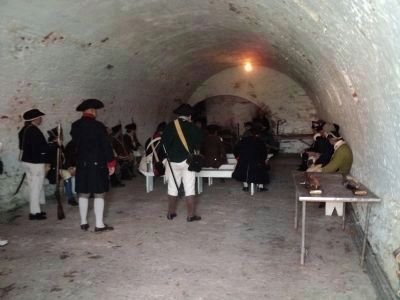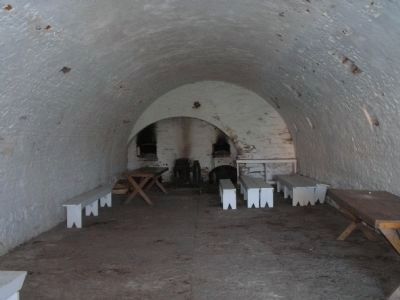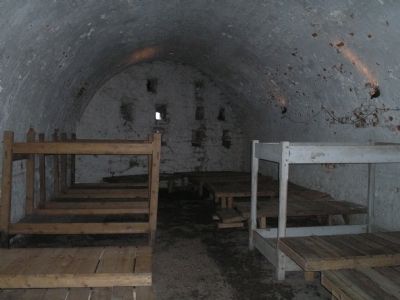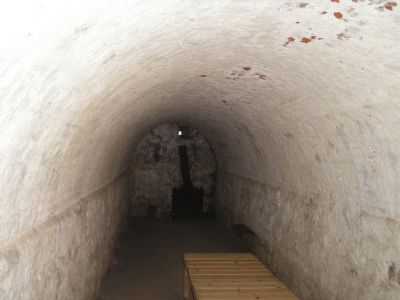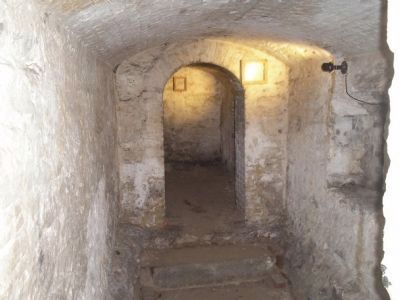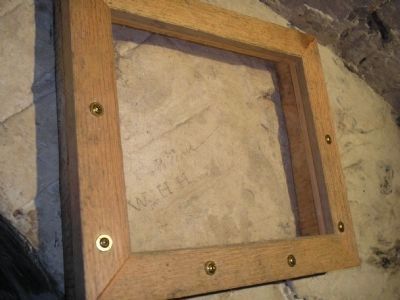Fort Mifflin in Philadelphia in Philadelphia County, Pennsylvania — The American Northeast (Mid-Atlantic)
Casemates or Bombproofs
1798
Report from the Fort
21 January 1802 • Major J. J. Ulrich Rivardi
The bombproofs are six in number and well arched.
No.1 - used as a guard house has two large bake ovens – its dimensions are 50 feet in length, 18 in width and 12 high in the center of the arch – it is well floored – is apt to leak in the spring.
No. 2 - used as powder magazine, being very dry, and isolated, is 68 feet long, 17½ wide and 12 feet high in the center of the arch.
No. 3 (empty) is 50 feet long, 18 wide, 12 high, has a good underfloor and a chimney.
No. 4 (empty) is 43 feet long, 7 wide, 7½ high, no chimney.
No. 5 (empty) is 34 feet long, 10 wide, 7 high, no chimney.
No. 6 (empty) is 39 feet long, 7 wide, 7 high, no chimney.
The large Bombproofs, having 12 feet in height could in time of War have a double row of Bunks or a Gallery so as to accommodate easily one hundred men each.
Report from the Fort
20 May 1807 • Jonathan Williams, Inspector of Fortifications
In the whole bastion at the northeast angle of the fort there are six large subterranean arches, and if they had been so constructed as to be tight, they would be a very valuable part of the fort. Unfortunately this is not the case and they of course are not habitable, nor capable of preserving stores that can be injured by moisture, one of them, however, appeared less damp than the others.
National Archives
In nearly every report on the fort the casemates are cited as leaking and deteriorating. Fortunately, they never had to be used during an attack, though they did serve as prisons. A convict sentenced to hard labor in 1801, and a corporal who deserted from his troop in 1842 and was placed in “double irons” may well have been kept in the casemates. Between 1863 and 1865 during the Civil War, Confederate deserters as well as Union soldiers and citizens awaiting trial were housed here. Double-decker bunks were constructed here for their use. In 1864 the prisoner tally rose to 216 rebel prisoners, 55 Union soldiers awaiting trial or sentence, and 11 other offenders. The damp, cold quarters brought illness and complaints of inhuman treatment and encouraged letters from family, friends, and influential groups for the release of prisoners. A signed Oath of Allegiance to the United States provided freedom for some.
The iron gate on the casemate entrance thwarted most escapes, but alcoholic drinks were smuggled to the prisoners and disobedience often occurred. In 1863, on Christmas Day, an uprising among the prisoners was even attempted.
Fort Mifflin, PA
December 27, 1863
Captain:
I have the honor to report that a very serious plot was discovered in the bomb proof on the night of the 25 inst. The Union prisoners, especially the prisoners whose sentences had been read to them on Parade, had it so planned that when the relief came into the bomb proof, knock the sentinel down on the outside, also the Sergeants of the guard whose duty it was to post the guard, take the keys from him and then the whole of the prisoners, both soldiers and citizens, make their escape. Happily the plot was discovered in good time to prevent it from being carried into execution. I have placed the Ringleader in close confinement.
I am Captain your obedient servant, J. Orr Finnie, Commander of the Post
One prisoner arrived with a murder charge, William H. Howe, a Union deserter who accidentally shot and killed an arresting officer, was tried and sentenced while at Fort Mifflin. He was found guilty, resulting in the only execution at the fort: death by hanging on August 26, 1864.
Erected by Fort Mifflin Historic Site.
Topics. This historical marker is listed in these topic lists: Forts and Castles • Notable Buildings • Notable Places. A significant historical date for this entry is January 21, 1802.
Location. 39° 52.53′ N, 75° 12.738′ W. Marker is in Philadelphia, Pennsylvania, in Philadelphia County. It is in Fort Mifflin. Marker can be reached from W Fort Mifflin Road, on the right when traveling east. Marker is along the walking tour of Fort Mifflin. Touch for map. Marker is at or near this postal address: 6400 Hog Island Rd, Philadelphia PA 19153, United States of America. Touch for directions.
Other nearby markers. At least 8 other markers are within walking distance of this marker. Artillery (a few steps from this marker); Quartermaster’s Store (a few steps from this marker); Arsenal (within shouting distance of this marker); What Makes Wetlands? (within shouting distance of this marker); Native Plants of Fort Mifflin (within shouting distance of this marker); Main Gate / Flag (within shouting distance of this marker); Soldiers’ Barracks (within shouting distance of this marker); Expert Fishers of Fort Mifflin (within shouting distance of this marker). Touch for a list and map of all markers in Philadelphia.
More about this marker. The marker contains a drawing of the floor plan for the six casemates. A reproduction of the Oath of Allegiance that was offered to some prisoners also appears on the marker, as well as a letter written by a group of Pennsylvania citizens requesting the release of a Confederate POW.
Transcription:
Mercersburg, August 25,1863
Franklin County, Pennsylvania
We the undersigned believing L.A. Pouillry, who is now held as a Prisoner of War at Fort Mifflin to be a true and loyal man to the government of the U.N. States, he gave himself up as a deserter during the invasion of Penna. and while the Rebel forces were here, we changed his clothing from a Rebel to a citizen dress, and kept him secreted for several days, when we sent him with others further north. After leaving us, he was apprehended and taken as a prisoner of war by our forces, we therefore pray he may be released.
John Shiers, James O. Camont, John Hoch, John Frail, R.M. Smail, John J.A. Orth, Jacob Brinkley
Historical Society of Pennsylvania
Related markers. Click here for a list of markers that are related to this marker. This series of markers follow the walking tour of Fort Mifflin.
Also see . . .
1. The Fort that saved America. The Official Website of Fort Mifflin on the Delaware. (Submitted on October 20, 2008, by Bill Coughlin of Woodland Park, New Jersey.)
2. Fort Mifflin Groundplan. Layout of Fort Mifflin, the Fort that saved America. (Submitted on October 20, 2008, by Bill Coughlin of Woodland Park, New Jersey.)
Credits. This page was last revised on February 2, 2023. It was originally submitted on October 20, 2008, by Bill Coughlin of Woodland Park, New Jersey. This page has been viewed 1,338 times since then and 16 times this year. Photos: 1, 2. submitted on October 20, 2008, by Bill Coughlin of Woodland Park, New Jersey. 3, 4, 5. submitted on November 11, 2013, by Bill Coughlin of Woodland Park, New Jersey. 6, 7, 8, 9, 10. submitted on October 20, 2008, by Bill Coughlin of Woodland Park, New Jersey.
